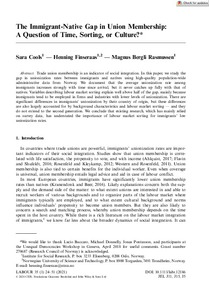The immigrant‐native gap in union membership: A question of time, sorting, or culture?

Cools, Sara ; Finseraas, Henning ; Rasmussen, Magnus Bergli
Labour. Review of Labour Economics and Industrial Relations
2021
35
1
March
24-51
trade unionization ; membership ; immigrant ; migrant worker ; social integration
Trade unionism
https://doi.org/10.1111/labr.12186
English
Bibliogr.
"Trade union membership is an indicator of social integration. In this paper, we study the gap in unionization rates between immigrants and natives using high‐quality population‐wide administrative data from Norway. We document that the average unionization rate among immigrants increases strongly with time since arrival, but it never catches up fully with that of natives. Variables describing labour market sorting explain well above half of the gap, mainly because immigrants tend to be employed in firms and industries with lower levels of unionization. There are significant differences in immigrants' unionization by their country of origin, but these differences are also largely accounted for by background characteristics and labour market sorting — and they do not extend to the second generation. We conclude that existing research, which has mainly relied on survey data, has understated the importance of labour market sorting for immigrants' low unionization rates."
Digital
The ETUI is co-funded by the European Union. Views and opinions expressed are however those of the author(s) only and do not necessarily reflect those of the European Union or the ETUI.